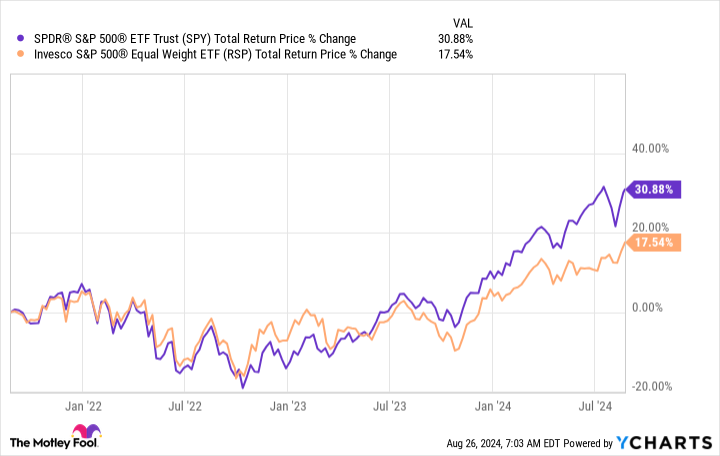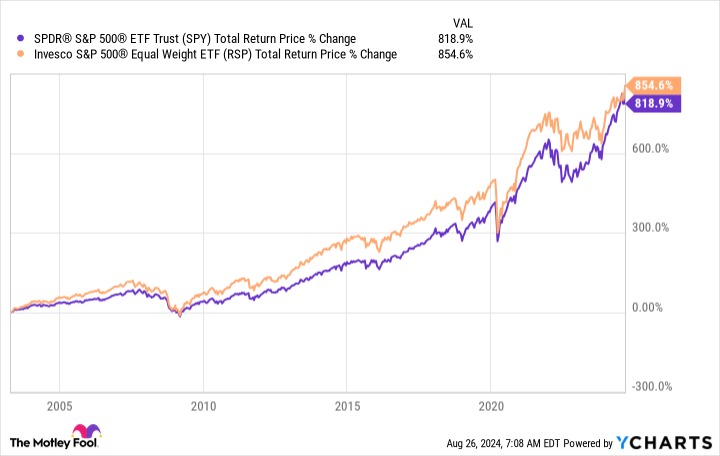One of the most important aspects of the S&P 500 index is the way it is weighted. While its market-cap weighting approach was an improvement over the way the Dow Jones Industrial Average was designed, it exposes the S&P 500 index — and any products that track it — to extra risk during periods of excess.
That’s why adding the Invesco S&P 500 Equal Weight ETF (NYSEMKT: RSP) to your portfolio might be a no-brainer move today if you have $1,000 in cash available to invest.
Why is weighting so important for the S&P 500 index?
When the Dow Jones Industrial Average was created, people had to do math by hand.
So back when it became the primary gauge of market performance, the people who devised it picked a simplistic method for calculating its level: You just take the stock prices of each of the 30 selected stocks and divide by 30. (That’s actually an oversimplification: The method also requires you to divide by the “Dow Divisor,” which is adjusted to take things like stock splits into consideration.)
Because of this, at the end of the day, the stocks that have the biggest impact on the movements of the Dow — which you can invest in with SPDR Dow Jones Industrial Average ETF (NYSEMKT: DIA) — are those with the highest stock prices. That’s not ideal.
By contrast, the S&P 500 index is market-cap weighted. This means that the largest companies by size have the largest impact on its performance because they make up the largest portion of the index. That makes more sense since the largest companies are normally going to be the most important companies in the economy. The index also tracks 500 companies, in contrast to the 30 in the Dow.
Generally speaking, that far wider diversification is a key reason the S&P 500 index is considered a better way to track the market than the Dow Jones. The SPDR S&P 500 ETF (NYSEMKT: SPY) is the go-to exchange-traded fund (ETF) for tracking the S&P 500 index. Indeed, it’s one of the oldest ETFs in existence.
However, there are still some potential pitfalls involved in investing in a product that tracks the S&P 500 index since the most popular stocks tend to be the largest stocks. This can feel good when Wall Street is on the way up, but it can lead to extra pain when a bull market switches to a bear market.
Why Invesco S&P 500 Equal Weight ETF is attractive right now
The market goes up and it goes down — that’s just how Wall Street works. And, usually, when the market goes up a lot there’s excess enthusiasm that will eventually get washed out through a correction (a market drop of 10% or more from its peak) or, worse, a bear market (a market drop of 20% or more). Right now the stock market is hovering near all-time highs, but a small number of megacap companies are driving much of the market’s movement. There’s a way to soften the blow this is likely to have in a market downturn — equal weighting. That’s the methodology used by the Invesco S&P 500 Equal Weight ETF.
Essentially, it takes the same list of stocks that are in the S&P 500 index, but assigns them all the same dollar investment, then periodically rebalances its portfolio to bring each company’s portion of the total back into parity. This means that the stock movements of the largest companies in the index have the same impact on its performance as the smallest companies. That makes a big difference, particularly at times like these, as the chart below highlights. Notice how the equal-weighted Invesco ETF is lagging the market-cap-weighted ETF.
Take particular notice of how the S&P 500’s total return, which assumes the reinvestment of dividends, has taken off over the past year or so. That’s basically the time when the so-called “Magnificent Seven” stocks started to be the primary driver of the moves of the broad market index. Yes, it feels good to own those stocks through a market-cap-weighted index when they are rising sharply, but in a bear market, those types of stocks are often the ones that fall the hardest. If that happens, it will feel much better to be invested in an index that owns shares of all the same companies, but with an equal weighting, since the steep declines of a small handful of them won’t have quite so painful an impact on your returns.
In fact, the drawdowns of those stocks could even be offset to some degree by the fact that during market corrections, investors tend to flock to stocks considered safe havens, like utilities and consumer staples companies. Since the moves of those stocks will have the same impact on an equal-weight index’s performance as all of the others, they can help soften the blow from the stocks that may be imploding. If you are wondering how helpful that can be, notice in the chart above that the Invesco S&P 500 Equal Weight ETF has outperformed the S&P 500 over a 20-year period.
Prepare for the worst today
This isn’t to suggest that you should put all of your money into Invesco S&P 500 Equal Weight ETF. However, it might be a good idea to hedge your bets a little if you have a lot of your portfolio in market-cap-weighted funds like the SPDR S&P 500 ETF. That way, when the bad times eventually come — and they will eventually come, if history is any guide — you won’t have to bear the full brunt of the pain that is likely being set up thanks to the small number of hot stocks driving the market higher.
Should you invest $1,000 in Invesco Exchange-Traded Fund Trust – Invesco S&P 500 Equal Weight ETF right now?
Before you buy stock in Invesco Exchange-Traded Fund Trust – Invesco S&P 500 Equal Weight ETF, consider this:
The Motley Fool Stock Advisor analyst team just identified what they believe are the 10 best stocks for investors to buy now… and Invesco Exchange-Traded Fund Trust – Invesco S&P 500 Equal Weight ETF wasn’t one of them. The 10 stocks that made the cut could produce monster returns in the coming years.
Consider when Nvidia made this list on April 15, 2005… if you invested $1,000 at the time of our recommendation, you’d have $731,449!*
Stock Advisor provides investors with an easy-to-follow blueprint for success, including guidance on building a portfolio, regular updates from analysts, and two new stock picks each month. The Stock Advisor service has more than quadrupled the return of S&P 500 since 2002*.
*Stock Advisor returns as of August 26, 2024
Reuben Gregg Brewer has no position in any of the stocks mentioned. The Motley Fool has no position in any of the stocks mentioned. The Motley Fool has a disclosure policy.
1 No-Brainer S&P 500 ETF to Buy Right Now for Less Than $1,000 was originally published by The Motley Fool


